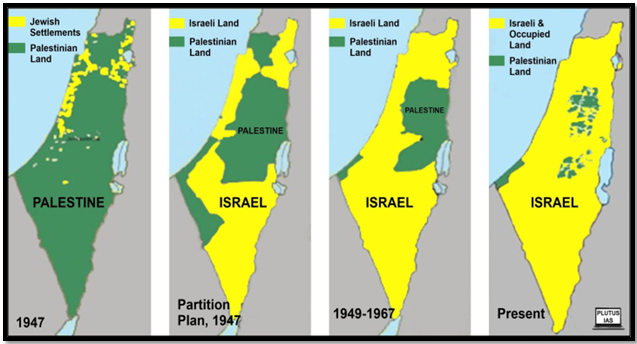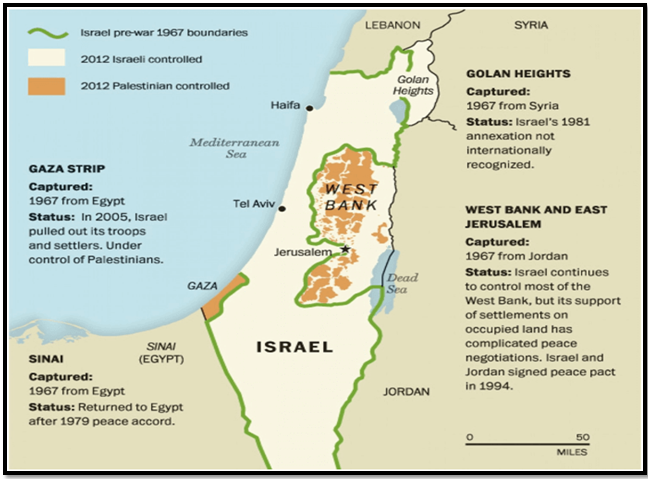“THE TWO-STATE SOLUTION “
Syllabus:
- GS-1- World History ,Israel Palestine historical context
- GS-2- Bilateral relations of Israel, Palestine and India ,International security
Focus :
- The article focuses on the historical context, challenges, and recent developments surrounding the two-state solution for the Israeli-Palestinian conflict.
- It highlights the structural obstacles to achieving a sovereign Palestinian state, international diplomatic efforts, and growing global support for resolving the Palestinian question to ensure lasting peace in the region.
Source-IE
Source - Present Map -IE
Recent Developments in the Israeli-Palestinian Conflict
- Hamas’s attack on Israel on October 7, 2023, and Israel’s subsequent war on Gaza have intensified focus on the Palestinian issue.
- The conflict has resulted in the destruction of Gaza and the death of 36,000 Palestinians.
- More countries are voicing strong support for a future Palestinian state, with Spain, Ireland, and Norway recently recognizing it.
- Arab countries like Saudi Arabia and Jordan insist that lasting peace in the region requires resolving the Palestinian question.
- An internationally recognized solution, the two-state solution, aims to address this ongoing conflict.
What is the Two-State Solution?
- The two-state solution proposes dividing historical Palestine into an Arab state and a Jewish state.
- Historically, Israel, a Jewish state, was created in Palestine in 1948, but a Palestinian state has yet to materialize.
- Since 1967, Palestinian territories have been under Israeli occupation.
- Today, the two-state solution means creating a legitimate, sovereign Palestinian state with full rights under the UN Charter.
- This solution is complex due to historical, political, and territorial disputes between Israelis and Palestinians.
Historical Origins of the Two-State Solution
- The roots of the two-state solution date back to the 1930s under British rule over Palestine.
- In 1936, the British government appointed the Peel Commission to investigate Arab-Jewish clashes.
- The Peel Commission proposed a partition of Palestine into Jewish and Arab states, but Arabs rejected the proposal.
- After World War II, the UN proposed another partition plan, dividing Palestine into Jewish, Arab, and international territories.
- The UN General Assembly adopted this plan (Resolution 181), but Arabs rejected it, leading to the creation of Israel in 1948 and subsequent conflicts.
International Legitimacy and Further Developments
- In the 1967 Six-Day War, Israel captured the West Bank, East Jerusalem, Gaza Strip, Sinai Peninsula, and Golan Heights.
- Palestinian nationalism, led by the Palestine Liberation Organization (PLO), gained strength in the 1960s.
- The PLO recognized the two-state solution based on the 1967 borders, but Israel initially rejected Palestinian claims.
- The Camp David Accords after the 1973 Yom Kippur War led to Israel agreeing to a framework for Palestinian autonomy.
- The Oslo Accords (1993, 1995) formalized the two-state solution, creating a Palestinian National Authority and recognizing the PLO.
Challenges to Achieving the Two-State Solution
The assassination of Israeli Prime Minister Yitzhak Rabin in 1995 was a significant setback to the Oslo process.
- The rise of Hamas, which opposed the Oslo Accords, further complicated peace efforts.
- Multiple diplomatic efforts have since failed to revive the two-state plan.
- Structural factors, including undefined borders and illegal settlements, hinder progress.
- Israel’s right-wing leadership shows little willingness to make necessary concessions for peace.
Key Structural Factors and Issues
- Undefined Borders: Israel lacks clearly demarcated borders and has historically expanded its territory.
- Settlers: Approximately 700,000 Jewish settlers in the West Bank and East Jerusalem pose a major obstacle to withdrawal.
- Jerusalem: Disputes over Jerusalem’s status, with Palestinians claiming East Jerusalem and Israel claiming the entire city as its capital.
- Right of Return: Around 700,000 displaced Palestinians seek the right to return, which Israel opposes.
- Political Leadership: Israel’s right-wing government prefers maintaining the status quo of occupation, while Palestinians seek to end it.
Recent Diplomatic Efforts and International Support
- Despite ongoing conflicts, international support for a Palestinian state is growing, with several countries recognizing it.
- The Arab League and other regional bodies continue to push for a resolution to the Palestinian question.
- International organizations, including the UN, advocate for the two-state solution as the best path to lasting peace.
- Diplomatic efforts often face setbacks due to on-the-ground realities and political resistance from both sides.
- Continued advocacy and negotiation are essential to achieving a viable two-state solution.
Source:The Hindu
Associated Article
https://universalinstitutions.com/israel-palestine-conflict-and-unga-resolution/





